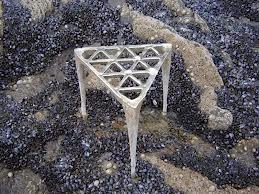FROM THE EARTH RICHES WILL COME
the awesome design and ideas of Max Lamb
By Griffin Goldsmith
 |
| Like a diamond, this came from the earth |
More than a few nights ago I went to a lecture by Max Lamb at the Workshop Residence in San Francisco. At first it felt like any other lecture, but Lamb’s ideas and his experiments have stayed with me and I want to relate what I think is so important about them. The Workshop Residence is a storefront-workshop-event space where different artists craftsmen and designers are selected to live and work for a period of time. The Workshop has chosen Lamb to participate in a residency this spring, and he was visiting San Francisco to try to figure out what he was going to work on during his stay. He had been in San Francisco for five days when he gave this lecture and he had clearly been inspired by what he had seen.
In his lecture Lamb mentioned that people have called him a performance designer due to his intense focus on process. The end product is never the result of thinking about an ideal piece and then finding a way to get there, but developing a process and then allowing that process to create what it will. For example, Lamb’s pewter stools are cast on the same beach in Western England where he spent his childhood. Lamb dug out the molds for the stools in the sand, melted down the pewter with a simple camp stove and then cast functional stools. It’s like digging sand castles to produce a highly crafted and functional artifact. This might seem fanciful, but I think Lamb’s experiments in fabrication are the future of making things. With the emphasis on process one doesn’t lose ideas to the demands of production. Designer Ross Lovegrove has referred to this type of fabrication process as “craftech” and has defined it as the “creation of manufactured components and products that are made from more experimental processes and material combinations.”
 |
| The alchemy of design |
My first exposure to ‘craftech’ was in 2010 here in San Francisco. The Yerba Buena Center for the Arts held a show called “Technocraft” curated by the designer Yves Behar, the head of fuseproject. The show got together many designers who are experimenting with material and process, and generally working outside the confines of mass production or any production at all. From going to the beach and digging holes in the sand to crafting a chair with sheet metal and a sledge hammer, craftech has put an emphasis on allowing the process to create the product. It is a highly personal aesthetic and allows for creativity that most design doesn’t. At this point most of these experiments do not make objects that are as accessible as a $10 Wal-Mart chair. However some of these projects use basic materials that one can find in any hardware store and put together in any living room. It’s a mode of production that accounts for the way in which the world naturally produces and designs products.
Let’s look at the pewter stool again. Lamb went out to the beach where he spent most of his childhood with a few assistants, some pewter, a shovel and a camp-stove. He then melted down the pewter, dug the holes for the mold of the stool and poured the molten pewter into the earth. Paying careful attention to the fluctuations of the tides, he let nature do what it always does—shape and reshape the world, create images of stunning beauty and work with precision and efficiency. What’s important to remember is that process is self-sufficient and does not rely on an industrial system of production.
Now let’s look at a counter example, a total product of production and capitalist design: Chair One. Konstantin Grcic created it for the Italian furniture company Magis, headed by Eugenio Perazza. Perazza offered Grcic the opportunity to create a die-cast aluminum chair and Grcic took him up on it partially because he knows that using die-cast aluminum is an inherently industrial process. Like Lamb’s work with the pewter stools, the process of production dictates a great deal of the end product. If nature is efficient or at least under Lamb’s guidance allows for efficiency, then Grcic is attempting to do something similar with die cast aluminum. He wants it to do what it naturally does, which, oddly enough, is to become a product. For both Lamb and Grcic, process is production and in each case the designers have sought a way to let the end product produce itself. Who said that alchemy was dead?
 |
| A different process, a different chair: Chair One |
The Pewter stool is an example of working innovation into the design of the product. Lamb’s process doesn’t just release nature’s creativity, a feat unto itself, but it also brings a distinctly human quality to his work, especially in the age of the computer. By choosing that particular beach and a process that brought him back to his childhood days of building sandcastles, Lamb almost demands that we see industrial design as an extension of our most human qualities. In the coming years I think designers should look to methods and processes that gets us closer to the past and what has made us human, rather than embracing modes of production that make us irrelevant adjuncts to the tyranny of mass production.
 |
| The Geometry of the Future |
©The CCA Arts Review and Griffin Goldsmith

No comments:
Post a Comment